
| start date | activity | country | place | from - to | days | km | km/ day | comment |
03.06.2013 |
organising |
Chile |
San Pedro de Atacama |
2 |
0 |
0 |
swapping equipment for 2 persons |
|
05.06.2013 |
desert cart |
Chile, Bolivia |
San Pedro de Atacama - Laguna Blanca |
2 |
54 |
27 |
Ewelina took most of the baggage and she was waiting in Bolivia |
|
07.06.2013 |
desert cart |
Bolivia |
Altiplano |
Laguna Blanca - Isla de Pescada |
16 |
394 |
24 |
together with Ewelina l/td>
|
23.06.2013 |
forced brake |
Salar de Uyuni |
Isla de Pescada |
1 |
0 |
0 |
pre sent luggage wasn't on the proper island - Ewelina's lost bag search expedition |
|
24.06.2013 |
desert cart |
Bolivia |
salt lakes |
Isla de Pescada - Sabaya |
5.5 |
164 |
29 |
|
Total
| 26.5 |
612 |
23 |
all with Ewelina besides 2 days from San Pedro and last half day |
||||
This stage is written by Ewelina:
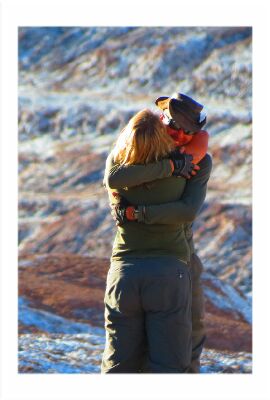 Minibus full of tourists is carrying me through the Martian landscape, but I can not concentrate. In a moment, after nearly four months break I will soak into Michal's arms. I am going for a sunset in the Valley of the Moon to meet him. My excitement spread among the whole bus and now everybody is looking for my husband. Everyone wants to spot him first so they run up and down the bus and I can not see anything.
Minibus full of tourists is carrying me through the Martian landscape, but I can not concentrate. In a moment, after nearly four months break I will soak into Michal's arms. I am going for a sunset in the Valley of the Moon to meet him. My excitement spread among the whole bus and now everybody is looking for my husband. Everyone wants to spot him first so they run up and down the bus and I can not see anything.
Finally, I hear ''Polaco loco'' - crazy Polish - and then the door opens, I run and run into the arms of Michael. People clap their hands, take pictures - we are the stars of Valle de la Luna.
The next few days we spent in San Pedro De Cama (to be truthful- de Atacama, but who cares?). Finally, when the cart (and us) are ready, we are off. Michael left the night before, because he has to climb 2000 metres up to the border with Bolivia. I get in the Jeep and ask the driver to stop by the boy pulling a cart with an almost dead duck. I reach the summit in time for the action of oxygen delivery to a tourist, who gets altitude sickness. I hope we do not, we both are quite acclimatised, but the effort at 4600 metres above the sea level it is not a normal walk.
 We go around the white and green lagoons. For trips that is only one stop, for us it is half day by the water. The cart shakes its body on an uneven surface, the wind blows - and we are happy and free.
We go around the white and green lagoons. For trips that is only one stop, for us it is half day by the water. The cart shakes its body on an uneven surface, the wind blows - and we are happy and free.
,,Free'' -because we do not need a ticket for a bus, nor be late for any train, no one waits for us. We set up the tent when we run out of energy, or the sun sets, or simply like the place. We move with a speed of 3-6 km per hour.
We park the cart at a pool, undress and jump from 0°C temperature to the hot thermal waters. Just as in the tub. Behind us, the first 40 km. Our bodies are steaming. Today, for a change, we sleep in a bed. A stone one, but still a bed. Refuhio - is like a simple hostel. I fall asleep under several blankets - at night temperature drops down to -15°C.
 In the morning, in front of the refuhio we have a conversation: Michael:
In the morning, in front of the refuhio we have a conversation: Michael:
- Somewhere here our cart was parked.
Ewelin
- And what it is at all?
M: - what is the problem with you? Can't you recognise the snow?
E: - you said that it is the dry season right now....
M: - Oh yes, and the snow definitely shouldn't be here. It surprised me as much as you. But there is nothing l can do about it now so it would be better if you help me to dig out the cart.
Frustrated, l took off my clothes and soak myself in the hot springs. A vicious snow poured on my head.
Can the desert cart manage to drive in the snow? Is Michael able to pull 130 kg in white fluff? Am I going to go crazy?
Come on. Here is so beautiful. Vast valleys, wonderful light. Laguna poured with blue. Tent somewhere in the middle of nothingness. As nomads, we daily set up our tent - house, pack it into the cart and go ahead. Just walk! We feel really great. Even the thousandth of the thousands snowflakes do not bother me anymore. But moments later, we see nothing. We are in a complete white out. Map, compass and we go forward. We walk all the time, because it is impossible to sit or cook in those conditions. It is a short day. After just 18 km I cant fight the weather anymore. The tent struggles with us, as if it feels the freedom and wants to fly somewhere too.
 - At least we won't run out of water, because we can always melt snow - says Michael.
- At least we won't run out of water, because we can always melt snow - says Michael.
But in the morning the snow is gone. We have plenty of water in 20 litres container but it is useless. Unless you tell me how to get block of ice through a small hole?
Uphill again. We are at the pass on 4914 metres above sea level with a little headache. I chew coca leaves. We breathe differently, as if every few breaths need one more deep one for supplementary oxygen. Next we see geysers Sol de Maniana. They look a bit like a factory. Lots of smoke and bad egg smell.
Sometimes l push a cart from behind. Yesterday when we walked in the snow-covered canyon Michael had to pull our house on wheels to the hill to find a better way. We have also installed a second harness and steep approach we can take in a tandem. Rarely, because I often do not have enough strength. I do not know how Michael sometimes does this, but I checked for wires sticking out of him and neither l found any batteries. Actually skin and bones only ...
Our roads are interspersed with a tourist trip's routes. The drivers often stop so tourists can take some pictures of the ''burro'' (donkey) pulling the cart. They congratulate us, wish good luck, even give candies, jelly beans from Australia, bananas and a lot of motivation. After a week we start to see the same drivers for the second or more time. We pass the beautiful scenery. Stones scattered as at the images of Salvadore Dali. Elsewhere stone tree formed from a rock.
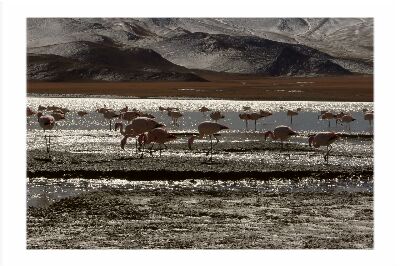

Our 4th Wedding Anniversary and Michael's 38 birthday is in June, just a few days apart. It snows heavy, we pass few whiteouts and decide to celebrate in the Hotel del Desierto, which is barely visible now. Luxury door open wide, laughing crew almost carry Michael and the cart to the centre of hotel's restaurant. Two plates of steaming soup are presented to the table even before we manage to sit. We get a great discount and eat romantic dinner by candlelight. The room in addition to a hot shower (which is very uncommon in Bolivia) had two rolled up towels into the swans shape waiting for us (swan is almost a duck, isn't?).
In Patagonia, when we walked the wind was so strong that they closed airports. Here, believe it or not, they closed the border and canceled some trips because of huge snowfall. What else is awaiting us?
Good things for a change. We come down leaving the snow on the high passes. Valleys are warmer with many lagoons, some full of pink flamingos. We spent try wo days with this amazing birds. The altitude drops to 3700 m. The cart is rolling over uneven ground. We keep walking.... .
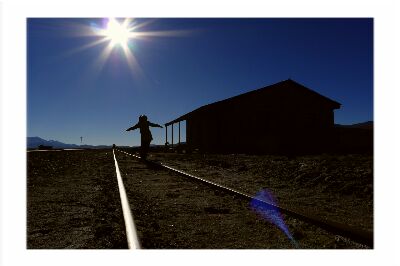 In 35 km there is Chiguana village. We walk whole day. Can l see a house? Or is it a rock? We are getting closer. There are railway tracks, a station boarded up, a burnt cemetery, a turn and the houses ... completely abandoned. Not a soul. Just something behind the fortified fence what looks like an UFO.
In 35 km there is Chiguana village. We walk whole day. Can l see a house? Or is it a rock? We are getting closer. There are railway tracks, a station boarded up, a burnt cemetery, a turn and the houses ... completely abandoned. Not a soul. Just something behind the fortified fence what looks like an UFO.
This is a military base - some green, concrete igloos with small windows. The entire staff of 5 boys come to greet us. In the evening, when we eat the soup, a sergeant tells us that they replaced the previous group just yesterday. The village has been abandoned for over 10 years. Michael shows map and ask for directions, but the lines on a topographic map do not tell them anything. We sleep inside ''the base'' and it is so nice of them to let us. In the morning Michal warns me
- Don't even think of taking pictures. Be aware that this is a military base.
- Yes, dear - l am trying to hide a camera from him. I already have 3 shots of the complex.
Meanwhile, two soldiers hang, as the laundry on the clothesline, thinly sliced meat of vikunia or lama.
- Would you like a photo? - they ask.
 After a few days of good weather, again we get a curse of the wind. The one in Patagonia 136 km/h didn't destroy our tent. That one here bent the aluminium poles. Must be strong. And here, at Salar, there is nothing to hide from it. Nothing? I can see something at the horizon. Abandoned excavator. The tent just fits between its belly and paw with claws.
After a few days of good weather, again we get a curse of the wind. The one in Patagonia 136 km/h didn't destroy our tent. That one here bent the aluminium poles. Must be strong. And here, at Salar, there is nothing to hide from it. Nothing? I can see something at the horizon. Abandoned excavator. The tent just fits between its belly and paw with claws.
We are not yet on the pure salty desert we dreamed about. This one is somewhat greyish. The first settlement is Aquaqiza and this time wind help us with strong push. Along the way, we fantasise what we will eat such as steak and if there are shops full of cheese and chocolate. But in reality I look forward to lama's soup and some eggs. However, just before the village we are surprised by an unexpected attraction - the whole hill of petrified cacti. Elderly man invites us to visit two caves. One is like a cave under the sea, full of fossilised coral. Just the water was gone millions years ago. In the other - there are holes in the ground full of skeletons and skulls of Chullapa tribe.
 We are fascinated by it. In the village there is no cheese or chocolate. But before we get disappointed we see amazing hostel on the hill. We didn't expect something like that in a village with maybe 15 houses. And it is not just like any hostel. In fact, it is perfect, inexpensive and will save us two days of walking. All is constructed with salt and cactus wood. We had planned detour to sleep in one of salt hotels. And there one arose on our way. It's beautiful. Salt bricks are arranged into semi-circular walls, tables and chairs are done with salt plates and covered with local patterned fabrics, a spotless floor strewn with salt, and the slim, salt lama eyeing us from the corner. Whatever is not made from salt is the cacti wood. Include our bed, but without spikes. Bar, lamps, sculptures - all cactus. On the top of that luxury there is electricity and hot water. I had the steak from lama. We feel like we have discovered a secret for 5$ per person. We recommend this place.
We are fascinated by it. In the village there is no cheese or chocolate. But before we get disappointed we see amazing hostel on the hill. We didn't expect something like that in a village with maybe 15 houses. And it is not just like any hostel. In fact, it is perfect, inexpensive and will save us two days of walking. All is constructed with salt and cactus wood. We had planned detour to sleep in one of salt hotels. And there one arose on our way. It's beautiful. Salt bricks are arranged into semi-circular walls, tables and chairs are done with salt plates and covered with local patterned fabrics, a spotless floor strewn with salt, and the slim, salt lama eyeing us from the corner. Whatever is not made from salt is the cacti wood. Include our bed, but without spikes. Bar, lamps, sculptures - all cactus. On the top of that luxury there is electricity and hot water. I had the steak from lama. We feel like we have discovered a secret for 5$ per person. We recommend this place.
Today is the first day of walking at the Salar de Uyuni - the beautiful, white, salt space. The cart is rolling fast at a hard, glossy surface. The sun is setting down and everything is pink as flamingo's bottoms. The temperature drops quickly so l buried myself into sleeping bag.
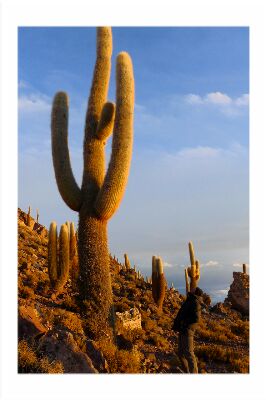 We went to the bottom of the sea. We are like ships sailing next to each other. The ocean has no water - just salt. But when the wind inflates us like a sail I really think that I can hear the noise and see swaying horizon. Even before reaching the Salar I felt that I went on the dry expanse of the ocean. Pampa looked like an overgrown with coral and seaweed. There were the caves of coral. Looks like another combination ofq Michael passion to desert with my love for the sea.
We went to the bottom of the sea. We are like ships sailing next to each other. The ocean has no water - just salt. But when the wind inflates us like a sail I really think that I can hear the noise and see swaying horizon. Even before reaching the Salar I felt that I went on the dry expanse of the ocean. Pampa looked like an overgrown with coral and seaweed. There were the caves of coral. Looks like another combination ofq Michael passion to desert with my love for the sea.
Now, we can see our destination - Isla de Pescada. There, two weeks ago, I sent with a tour one bag full of food and equipment. It was late in the afternoon when we reached the shore of the island. It has shape like a lizard with the head facing us. We do not know whether the village (?) or Senior Lasarus' house will be on the left or right side. We draw the right one and soon it turns out to be wrong decision. There is no sign of people, but here and there we see the car wheel marks. We are exhausted but we have to go around and ... nothing. NOTHING! Not a single house. But even if the senior has died should be something left, some cottage, grave, ruis.
22 km from us is another island Isla de Incauhasi. It is very popular with tours. Is it possible that it is called colloquially Pescada? It is not much difference 22 km for someone in the car. For us - there and back is two days away. And to the south-east, so in the opposite direction. We are considering various options. In the end I decide that I will go alone. The weather is beautiful, easy to navigate - I can see the island at a glance. I'll be back by car, it must be possible to rent one. Michael would have to go back and forth, because he never broke the rule of un-motorized trip.
I'm going alone. Michael disappeared from my sight after less than a kilometre. I have a lot of time, thoughts float away. I am fast and after 5 hours I'm on the island. Senior Lasarus is smiling, helpful old chap. I take a bag and go back to Michael with one of tours' car. That evening, we are squalling around the island and photographing big cacti - high for several metres. From the island I brought the eggs. Only I forgot salt ... ups. This product actually we have in abundance.
 At the night salar does not reflect the stars. Full moon rises, but there are clouds. It's one of the cooler nights. Wind blows in our faces. Our speed rate is falling. Pulling the foot by foot, cart is slow too. The sun breaks through the clouds showing us the new face of Salar - the whole area is covered with polygons. They are formed of thin lines and unregulated pieces of salt. Beautiful.
At the night salar does not reflect the stars. Full moon rises, but there are clouds. It's one of the cooler nights. Wind blows in our faces. Our speed rate is falling. Pulling the foot by foot, cart is slow too. The sun breaks through the clouds showing us the new face of Salar - the whole area is covered with polygons. They are formed of thin lines and unregulated pieces of salt. Beautiful.
As we leave the Salar de Uyuni, road leads us to the village Llica. In the village everyone is staring at us. Michael ordered four dinners. This is just a stop, the isthmus of land, which separates us from the other salt desert Salar de Coipasa. People scare us, that is covered with water. It would be terrible for us, because we are planning to use some shortcuts.
Along the way we meet an old, fragile man, who carries a packet of branches at his back. He must walk from very far away because around are only arid mountains. The village should be a few kilometres away so we offer help. Grandpa says hardly anything, Michael puts an additional 20 kg on the truck and head off. Although we are with the local man, the village does not feel friendly. We asked for water, they show well, but no one seems to borrow a bucket.
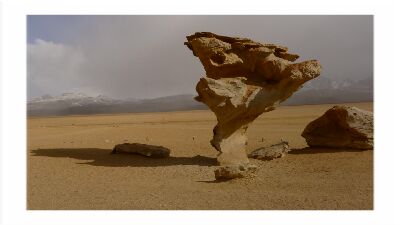
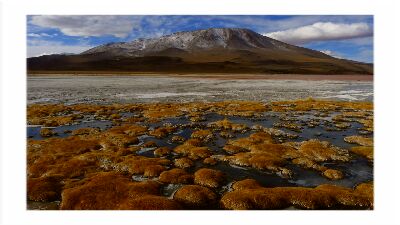
We pass a few half-abandoned villages before the truck wheels sink into the muddy earth mixed with Coipasa salt. There's no water, but it is not easy and we do not know what will happen next. Snoozing in the dark.
This is great! After two hours, sinking in the mud mixed with the salt we get on a hard, shiny surface of the Salar. It is so great, there is no wind, clouds, glide like a highway. This is our last moments together. From Coipasa I'll catch a transport back to civilization. And Michael continue alone.... So much about the planning.
And now reality. Coipasa is small village where the damaged cars driving circles through the streets. Lady of hospedaje left a few days ago and no one knows when she will come back. Sabaya is another 35 km away. We're on our last hike together.
Bus shaking terrible. On the road of dusty town Michael stands with his cart. Duck waving her paw. Dust caught my eye. A lot of dust ....
Michael's comment:
I wish everyone to have a so wonderful travel mate as Ewelina is - 600 km walking without whining!
| Country | Days | Food | (how many) paid accom. | Permits Entry fees |
Guide hire | Equipment purchase, hire |
Equipment or other freight fees | *Transport | Other | Total |
| Chile, Bolivia | 26.5 | $474 | (9) $72 | $23 | $0 | $99 | $65 | $0 | $38 | $771 |
